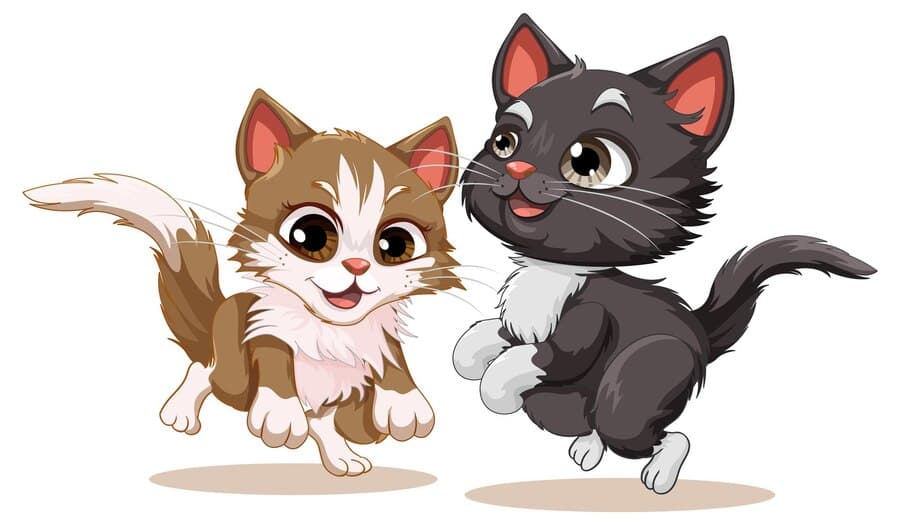If you’ve ever wondered how to draw a cartoon cat and bring it to life on paper, you’re in the right place. This step-by-step guide will not only walk you through the process but also provide valuable tips and insights for beginners. From choosing the right tools to adding vibrant colors, let’s explore the art of creating an adorable cartoon cat.
Tools and Materials
Before diving into the drawing process, gather the necessary tools and materials:
- Sketchpad or Drawing Paper;
- Pencils (HB, 2B, 4B);
- Eraser;
- Fine-tipped Pens or Markers;
- Coloring Materials (colored pencils, markers, watercolors).
Step-by-Step Guide: Drawing the Cartoon Cat
- Head and Facial Features: Begin with a basic oval shape for the head. Add large, expressive eyes and a small nose. Don’t forget to include pointy ears and a friendly mouth;
- Body and Tail: Extend from the head to create a rounded body. Draw a curved tail, giving your cartoon cat a playful and dynamic pose;
- Legs and Paws: Sketch simple, curved lines for the legs and add small paws at the bottom. Ensure the proportions match the overall size of your cartoon cat;
- Adding Whiskers and Details: Incorporate whiskers on each side of the nose. Refine facial features, adding eyebrows or additional details to give your cartoon cat a unique personality.
Tips for Beginners:
- Start with Basic Shapes: Break down the drawing into simple shapes to establish proportions and positioning;
- Practice Facial Expressions: Experiment with different expressions to convey emotions in your cartoon cat;
- Use Light Strokes: Begin with light pencil strokes to allow for easy corrections and adjustments;
- Explore Different Styles: Don’t be afraid to experiment with various cartoon styles to find what resonates with you.
Choosing the Right Medium
Deciding on the medium for your cartoon cat drawing depends on personal preference:
- Pencils: Ideal for beginners due to ease of control and correction;
- Markers: Provide bold lines and vibrant colors;
- Watercolors: Offer a softer, more delicate look to your cartoon cat;
- Adding Color to Your Cartoon Cat: Once your outline is complete, consider adding color using colored pencils, markers, or watercolors. Experiment with shades and textures to bring your cartoon cat to life.
Common Mistakes to Avoid:
- Overcomplicating Details: Keep it simple, especially if you’re a beginner;
- Ignoring Proportions: Ensure body parts are proportionate for a balanced look;
- Skipping Basic Shapes: Building on a solid foundation of shapes is crucial for accuracy;
- Using the Wrong Medium: Experiment to find the medium that suits your style and preferences.
Step-by-Step Guide to Drawing a Series of Cartoon Cats in Motion
Step 1: Dynamic Pose Selection
Choose dynamic poses that showcase the agility and movement of cartoon cats. Consider poses like leaps, stretches, or playful rolls to infuse energy into your series.
Step 2: Motion Lines Integration
Incorporate motion lines to emphasize movement. Experiment with streaks, curves, or dashes to guide the viewer’s eye and convey the sense of action in your illustrations.
Step 3: Varied Expressions
Ensure each cartoon cat in your series has a range of expressions that complement its motion. From wide-eyed excitement to contentment, diverse expressions add depth to the visual narrative.
Step 4: Playing with Perspectives
Experiment with different perspectives to capture varied angles of your cartoon cats in motion. Overhead views, side angles, and close-ups offer a dynamic visual experience.
Step 5: Consistency in Style
Maintain a consistent artistic style across the series. While poses may differ, a cohesive style ties the illustrations together, creating a harmonious collection.
Step 6: Storytelling through Sequence
Arrange your cartoon cats in a sequential order to tell a story. Create a narrative flow, allowing viewers to follow the sequence of movements and actions.
Explore how to draw cat’s face in a better way in this tutorial
Step 7: Details that Convey Motion
Pay attention to details that enhance the sense of motion, such as fur ruffling in the wind or tail positioning. These subtle elements contribute to the realism of your cartoon cats.
Step 8: Diversifying Environments
Change the environments to add variety to your series. Urban settings, natural landscapes, or fantastical realms can complement the motion and storytelling in your illustrations.
Step 9: Seeking Feedback
Share your series with fellow artists or art communities to receive constructive feedback. External perspectives can offer valuable insights for refinement.
Step 10: Animation Exploration
Consider transforming your static illustrations into animations. Experiment with GIFs or short sequences to add an extra layer of dynamism to your cartoon cat series.
Step 11: Incorporating Props and Accessories
Introduce props or accessories that enhance the storytelling. Consider objects like bouncing balls, butterflies, or paw prints that complement the actions of your cartoon cats.
Step 12: Facial Expressions in Motion
Highlight facial expressions during dynamic movements. Expressive faces deepen the emotional connection between viewers and your cartoon cat characters.
Step 13: Engaging with Your Audience
Connect with your audience through timelapse videos or live drawing sessions. Engaging with viewers builds a community around your art and provides instant feedback.
Step 14: Mastering Backgrounds
Advance your skills by creating detailed backgrounds. Well-crafted settings, whether urban or natural, contribute to the overall visual storytelling of your cartoon cat series.
Step 15: Reflecting on Progress
Take moments to reflect on your artistic journey. Compare earlier illustrations with newer ones to observe growth and identify areas for improvement.
Step 16: Encouraging Others to Create
Inspire others by sharing your process, tips, and encouragement. Fostering a supportive community contributes to the collective passion for cartoon cat art.
Conclusion
Drawing a cartoon cat is not just about putting pencil to paper; it’s a journey of self-expression and creativity. Armed with the right tools, a step-by-step guide, and valuable tips, you’re ready to create your own charming feline masterpiece. So, grab your sketchpad and let your imagination run wild as you embark on this artistic adventure!
